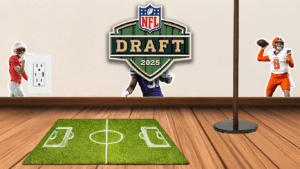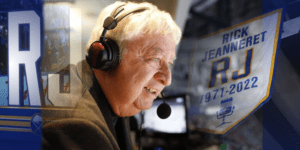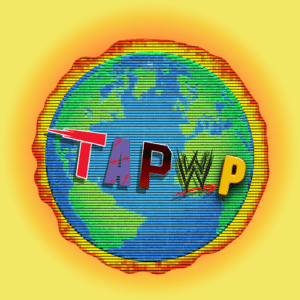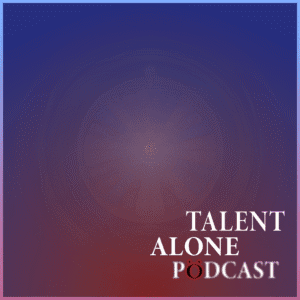Tankology: Kevin Durant & Russell Westbrook
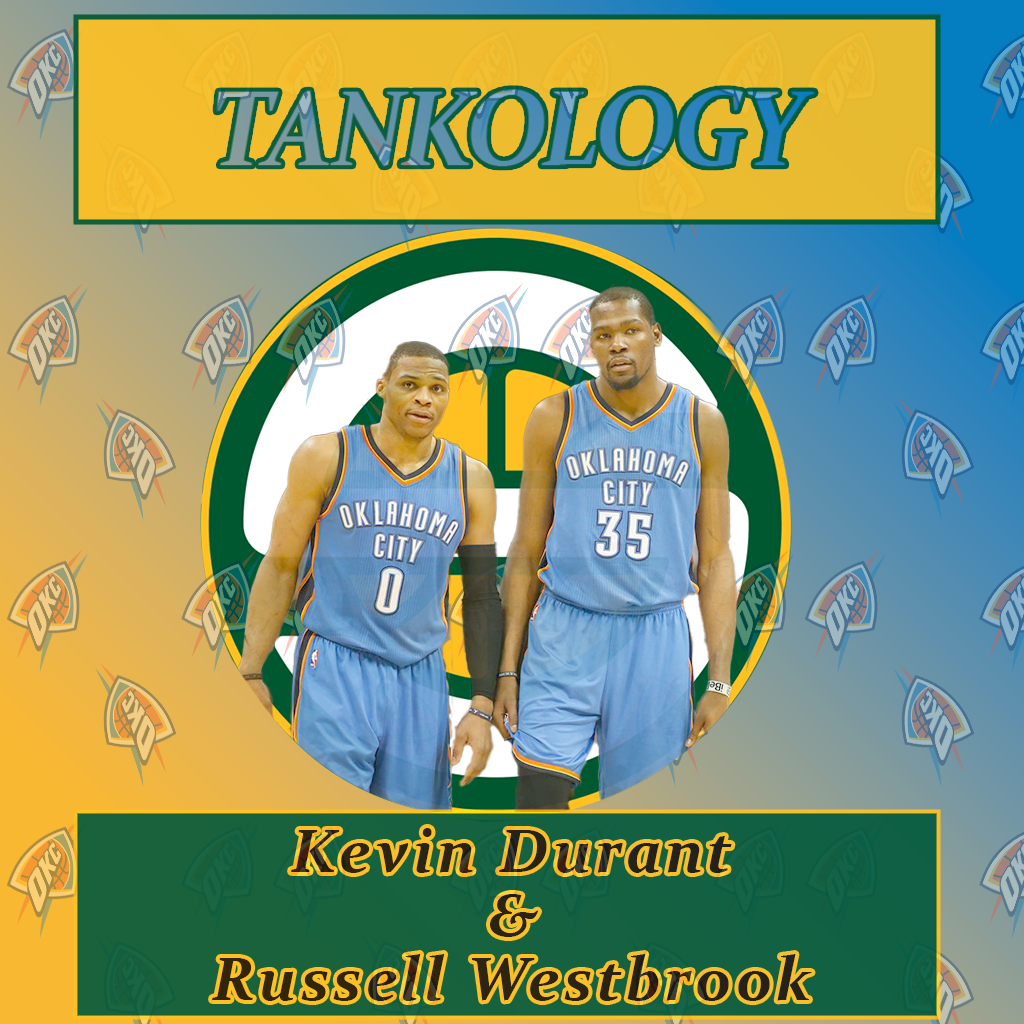
There are many types of scientific studies. You have biologists, chemists, epidemiologists, and even Scientologists. Those fields are all child’s play though compared to my area of expertise. I am a Tankologist. I study sports tanks to help better understand just how often they actually work, and see if “Tank or Titles” are words to live by or a cynical dangerous mindset. Now I am going to be bringing my findings here to Talent Alone. I’m going to go through some of the most iconic Tank Jobs in history and see if these savants of sucking were successful.
Welcome fellow Tanking aficionados! It’s Talent Alone’s resident Tankologist Mike Regan and I am back with another sports tanking study. With the NBA draft upon us, it seems like a great time to look at an NBA case study. There are many great ones to choose from, The ‘03 Cavs, the post-Kobe Lakers, or Sam Hinkie’s magnum opus was the Process.
However, I decided to go with one that had many layers to it. A tank that wasn’t just about rebuilding a team, but relocating it. Today we will be taking a look at the Seattle Super Sonics who tanked their way into two generational talents, and to a new city.
The Player(s):
Kevin Durant
Kevin Durant played just one season at the University of Texas, but it was apparent during his single year as a Longhorn that he was NBA-ready. Durant posted a team-best 25.8 points per game and 11.1 rebounds per game while shooting an impressive 47% from the field and 40% from three. He helped lead the team to the fourth seed in the NCAA tournament where the Longhorns would make it to the second round before losing to USC. However, Durant did show his ability to perform under big-game pressure. During Texas’ three games in the Big 12 conference tournament and his two in the NCAA tournament, KD averaged an unreal 29.8 ppg.
Durant was ranked the number two recruit in the nation, behind Greg Oden, coming out of high school, so it was no surprise he would be a one-and-done. At the combine, Durant measured in at 6’ 10” and 215 lbs with a 9’ 2” standing reach and a 7’ 4.75” wingspan. He had something that can’t be taught, length.
Outside of the measurables, KD had great athleticism and a beautiful jump shot. On top of his shooting, Durant showed impressive ball handling and passing. It was clear he was NBA-ready, and whoever drafted him would be getting someone with the potential to put his name in the franchise record books. However, there was one small question scouts had.
How much can he bench?
In the lead-up to the draft, there was a lot made about Durant’s more slender frame, weighing only 215 lbs despite his impressive height. This narrative would only gain traction after he failed to do a single rep at the combine on the 185 lb bench press (Not the case anymore). This very well could’ve ended up being the difference maker on draft night, where the Portland Trail Blazers would opt to select Ohio State center Greg Oden Jr. at number one overall. Not the first time Oden would edge out Durant for number one for the second time in their young careers. I won’t go into detail on how the two men’s careers ended up comparing. We all know that story.
Russell Westbrook
Many may be surprised to know that Russell Westbrook was not one-and-done in college. He actually spent two seasons at UCLA. However, his freshman year was spent coming off the bench, only averaging nine minutes a game. It wasn’t until year two that Westbrook would get his chance to show the type of dynamic player he could be, and his ability to stuff the stat sheet. He would finish his final season as a Bruin shooting 46.5% while averaging 12.4 pts, 3.9 rebounds, and a team-leading 4.3 assists per game. Along with fellow future NBA players Kevin Love and Darren Collison, Russ led UCLA to a record of 35-4. The team won the PAC-10 conference title, ranked third in the final AP poll of the season, and earned a number one seed in that year’s NCAA tourney. Westbrook and the Bruins would make it all the way to the final before losing to a fellow one-seeded Memphis team, featuring Derrick Rose.
Coming out of high school in the same year as Durant, Westbrook was ranked 140th as a recruit. He was considered undersized by many NBA scouts. His combined measurements had him as 6’ 3.5″ and weighing 192 lbs. He didn’t have the raw size of KD. What made Westbrook a high draft pick was the same thing that’s been his biggest strength all his career. His motor. On the court, Westbrook showed great athleticism and quickness. He had high-level ball control and passing. However, what stood out most, was the way he attacked and drove to the basket. Westbrook had a drive and skill that made up for not being built like an NBA blue chipper. The man ranked 140th in his high school recruiting class would end up being a top 5 draft pick.
The Tank:
The downfall of the Seattle SuperSonics began on February 20th, 2003 when the team traded away one of the greatest players to ever wear a Sonics jersey, Gary Payton. The return wasn’t nothing, most notably a 1st round pick and Ray Allen being part of the package. Despite that Seattle continued failing to find success on the court. The team’s struggles on the court mirrored that of the ownership’s struggles off.
2-time presidential candidate Howard Schultz purchased the Seattle Supersonics in 2001. During his time as owner, he would find himself in a constant battle with the city of Seattle to help in funding a new stadium for the team. The Supersonics’ home court, Key Arena, was the smallest in the NBA. Fewer seats mean less money, and as a team, Seattle was already financially struggling. The team would find themselves near the bottom of the league in revenue, and according to Schultz were actually losing money, with the tiny arena being one of the factors. The NBA even sent in the big guns by having then-commissioner, David Stern, join Schultz in a meeting with the city to approve a deal for a new stadium. Despite their best efforts, thinly veiled relocation threats included, the city wasn’t willing to spend a dime in taxpayer money on a new stadium.
On July 18th, 2006, Howard Schultz sold the team to the Profession Basketball Club LLC, a group from Oklahoma City headed by Clay Bennet. Schultz believed Bennett was going to work to keep the team in Seattle and Bennett claimed the same as well. To many Seattle fans, this was a bald-faced lie. Bennet did propose building a new $500 million stadium, the most expensive in the NBA, in the suburbs of Renton, WA. The location was considered terrible traffic-wise, and Bennet was noncommittal when it came to the amount of private funding the group would put up. Many believed he went in with no intention of getting that deal approved, but just as a fake attempt to show he tried to keep the team there as per the “good faith effort” clause included in the purchase of the team. Making matters more transparent was on August 12th, 2007 when Aburey McLendon, a member and large financial backer of Professional Basketball LLC was quoted in an interview saying they didn’t buy the team to keep in Seattle but rather, to move it to OKC. More damning evidence would come to light during discovery in the court case Seattle v. Professional Basketball LLC when emails from April of 2007 surfaced of Bennett and his ownership group talking about wanting to hurry up and move the team to OKC. Bennet was quoted in the emails saying, “He was a man possessed” and would do everything he can to get it done. Shortly after the time of those emails, Bennett was in talks with the NBA and Stern on how he could terminate the remaining time on the team’s lease at KeyBank Arena. It was in September of that year that Bennett would make his move and announce his intent to do just that. During the team’s final season in the city, attendance continued to wane due to poor on-court performance. On top of that player media availability was limited throughout that season in a move that many felt was made to further disconnect the city from the franchise. On January 8th, 2008 Clay Bennett and company would sell the WNBA’s Seattle Storm to a local ownership group, severing another tie. As the end drew near, fans protested, lawsuits were filed, and even a new ownership group anchored by Steve Ballmer surfaced in an attempt to purchase the team. Ballmer went as far as to commit to providing 150 million dollars to a 300 million dollar renovation of Key Arena. Unfortunately, it was all in vain.
The NBA relocation committee would approve the team’s move by a vote of 28-2. The city’s last chance in keeping the team was the previously mentioned court case in which the city of Seattle sued Bennett’s group for attempting to break the terms of their lease. Fans would never know what the final ruling of that case would be, because before the judge could announce their ruling Bennet and the city reached a settlement agreement. In the end, Bennett’s ownership group would pay 45 million to get out of the lease early and would be on the hook for another 30 million in five years if Seattle came to a funding agreement to renovate KeyArena, and were not awarded a new NBA franchise. Just like that, the SuperSonics were over and The Oklahoma City Thunder were born.
As ruthless or duplicitous as Bennett’s tactics were. They pretty much followed the playbook of how to pull off a relocation. He purchased a struggling team with arena issues, he made moves to make the team perform even worse, which in turn impacted fan investment, attendance, and most importantly revenue. One team hurting financially hurts the revenue of the league which in turn hurts the other franchises. It made it easy for the league to greenlight the move to Oklahoma City. A city that Bennett helped arrange to successfully host the New Orleans Pelicans for two seasons following the disaster of Hurricane Katrina. The city of OKC was hungry for a franchise and the fans were ready to spend their money once they got one.
Now you may be wondering what all this has to do with the tank of the team. Well, the moves to tank the team out of Seattle go hand in hand with the teams tanking on the court. Good teams don’t end up relocating or have cities unwilling to fork over money to renovate an outdated arena. As the team’s relationship with the city deteriorated, so did the team.
Following his first season as owner, in which Seattle posted a 31-51 record, Bennett and the Sonics’ struck ping pong ball gold in the lottery receiving the number two overall pick. This put them in the position to draft the aforementioned Kevin Durant out of the University of Texas. With a new superstar in hand, it was time to start shedding salary. The same night of the draft Seattle traded star shooting guard Ray Allen to Boston. Ray Allen was one of only two players that kept Seattle somewhat competitive on a nightly basis. The other was small forward Rashard Lewis. Lewis would be traded a couple of weeks later to the Orlando Magic for a second-round pick. The moves continued throughout the front office and the bench. Gone was longtime team president and former SuperSonic Lenny Wilkens, along with GM Rick Lund. The team would even part ways with assistant coaches Detlef Schrempf and Jack Sikma, both of which were former SuperSonic players. This further removed historical Seattle ties from the organization and allowed Bennett to bring in his own regime, most notably General Manager Sam Presti.
Kevin Durants rookie season, and the only one in a SuperSonics’ jersey, was as advertised. The 19-year-old rookie shot 43% and led the team averaging 20.3 ppg on his way to winning Rookie of the Year. While Durant met expectations in his first year it wasn’t enough to make up for a depleted roster and a team shrouded in a relocation controversy. The team ended its final season in Seattle with an abysmal record of 20-62. They had the second-worst record in the league, and while the draft lottery wasn’t quite as favorable as it was the year prior, they still ended up with the 4th overall pick. The pick that was used to select the tenacious UCLA point guard, Russell Westbrook.
The team had a new young dynamic duo, a new name, and a new city to call home.
The Results:
The debut season for the Thunder wasn’t much to write home about. Following a 1-12 start under head coach PJ Carlisimo, he would be fired, and Scott Brooks would be given the job. The team ended up finishing 23-59, only three wins better than their final year in Seattle. However, in the wreckage of the NBA’s third-worst record, that season was the bright light of future success. KD continued to grow, posting 25.3 ppg and 6.5 rpg, while shooting 47.6% from the field and 42.2% from three. Year one Russell Westbrook also broke out to a hot start that showed early glimpses of what was to become. He averaged 15.3 ppg, 5.3 assists, and 4.9 boards. It was clear that they had something special in their two young stars. They also ended up with another high draft pick at number 3 overall. They used that on future Sixth Man of the Year, James Harden.
The 2009-2010 season was the breakout season for the Oklahoma City Thunder. The duo of Durant and Westbrook went to another level. KD posted a league-leading 30.1 ppg, and the kid who couldn’t get a rep on the bench press led the team with 7.6 boards a night. Westbrook showed no signs of a sophomore slump as he averaged 16.1 pts, 8 ast, and 4.9 rb a game. The two men led the team to a 50-32 record and the team’s first playoff berth. Even if it was short-lived, losing 4-2 in the first round to the eventual NBA champion Los Angeles Lakers. The Thunder were off and running.
In total, following OKC’s first season, The duo of Durant and Westbrook would take the Thunder to the playoffs five out of six years. The one miss was in the 2014-2015 season when Durant missed the majority of the year with a foot injury. They would reach the Western Conference finals 4 times, and the NBA Finals once. The lone finals appearance came in 2012 where they would lose in 5 games to the Lebron-led Miami Heat. The final time KD and Russ would play together for the Thunder would come in the 2016 Western Conference Finals. OKC would take the Golden State Warriors, the team that broke a single-season record by going 73-9, to seven games. Durant averaged 30 points and 8 rebounds in the series along with 1.7 blocks and steals a game. Westbrook put up 26.7 points, 11.3 assists, 7 rebounds, and an unreal 3.7 steals a game. Despite the pair’s performance, the Thunder didn’t have enough to defeat the defending champs.
In the off-season Kevin Durant would become an unrestricted free agent and in a much-criticized move would opt to not resign with OKC, instead signing with the team that knocked them out of the playoffs, The Golden State Warriors. Along with the team success that Durant helped the Thunder achieve, he finished his Oklahoma City career averaging 27.4 points and 7 boards a game while shooting 48.3% from the field and 38% from three. In 2014, as a member of the Thunder, he would reach the pinnacle of single-season success winning league MVP.
To this day, Durankt leads the Thunder in points per game, player efficiency rating (PER), and 3pt field goals made. Also, if you remove players who only played for the SuperSonics he leads the franchise in win share, value over replacement player (VORP), and is 2nd all-time in points scored.
Following the departure of KD the Oklahoma City Thunder became the Russell Westbrook show. A role he embraced. Westbrook seemed determined to prove he could carry the team post-Durant. In 2016-2017 Westbrook pulled off something that hadn’t happened in the NBA since Oscar Robertson did in the 1961-1962 season when he averaged a triple-double. Russ finished the season posting 31.6 points, 10.4 assists, and 10.7 rebounds a night while also shooting a solid 42.5%. Following the record season Westbrook would win the same award his former teammate received three years prior when he was named the league MVP. OKC would manage to make the playoffs that season but was eliminated in the first round.
Following Westbrooks’s heroics the prior season, the Thunder would acquire Indian Pacers star small forward Paul George via trade in the hopes of having another top player to pair with Westbrook would make them a title contender again. Westbrook would go on to once again average a triple the next two seasons. However, even with Paul George and Russ’s big numbers, the Thunder would find themselves knocked out in the first round in both years.
The 2018-2019 season would be Westbrook’s final season as a member of the Oklahoma City Thunder. After watching Kevin Durant leave with the Thunder getting nothing in return GM Sam Presti decided to be more proactive this time around. It was clear his team had hit a wall that they couldn’t get over in its current form. He also had a star in Russell Westbrook who may only be 30 but played the game in a way that put more miles on a player than usual. Prest decided it was time to break it down and rebuild. On July 10th, 2019 the Thunder traded Paul George to the LA Clippers for Danillo Galinari, Shea-Gilgeous Alexander, and 5 first-round picks. Then the following day on July 11th Presti made his second blockbuster deal when he traded Russel Westbrook to the Houston Rockets for Chris Paul and four first-round picks. With that, the era that defined the birth of the Oklahoma City Thunder was over.
In the time since the Westbrook deal, Sam Presti has continued to stockpile young players and draft picks. OKC have a bonafide superstar on their hands in point guard Shea-Gilgeous Alexander and their abundance of draft picks has started to bear fruit in the likes of Josh Giddey, Jalen Willaims, and Luguentz Dort. The team is in a nice position with many options open to them. They have cap space and a total of 9 first-round picks over the next three drafts. They can continue to build through youth but also are in a position to make a move for a superstar through free agency or trade if the time seems right.
Final Verdict:
The lone argument against this tank is that it never ended with the Thunder hoisting up the Larry O’Brien. That argument is short-sighted. The franchise had Either Durant or Westbrook on the team for 11 seasons and they went to the playoffs 8 times. When the duo was together they had numerous deep playoff runs. While Durant walked away, Presti did do a good job of flipping Westbrook and setting up the team for the future. The most important part of evaluating this tank is going back to how this all started. The brutal honesty of the situation is the Seattle SuperSonic was a team in a bad financial situation with a city that wasn’t willing to work with the team. As cold and calculated as the relocation was, it was a success. From 2011 – 2020 the Oklahoma City Thunder had a home game sellout streak of 419 games. The Paycom Center, formerly known as Chesapeake Energy Arena, and its seating capacity of 18,203 was sold out 9 years straight for Thunder games. While a new team in a new city that’s starved for pro sports will get a boost early post-relocation, that can quickly fade. Relocating a team, no matter how it looks on paper, is never a sure-fire success. We’ve seen plenty of franchises in different sports move multiple times. The reason the Oklahoma City Thunder have been successful financially is the same reason they were successful from an early point on the court. That reason is two men. Kevin Durant and Russell Westbrook, without them, the team’s relocation could’ve ended up a failed gamble. I rule this tank was a SUCCESS!
Special thanks to: Sports-reference.com, 247sports.com, and the Sonicsgate Documentary for providing research for this article
